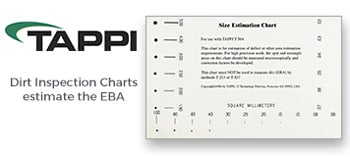 Search
Search
Use the search bar or filters below to find any TAPPI product or publication.
Filters
Publications
Level of Knowledge
Collections
Journal articles

Magazine articles

Enhancing tissue wet pressing performance and dry end material efficiency for cost savings, TAPPI Journal May 2024
ABSTRACT: The steadily growing global tissue paper demand lays a foundation for new technologies targeting tissue production optimization, as well as improved material and time efficiency. Tissue making is an especially energy-intensive field of paper industry, creating unique demands for performance in wet pressing and drying processes to cut energy usage. Intelligent roll solutions offer new tools for tissue making to achieve these goals. These tools aim at improving press nip, moisture, and tension profiles; reeling nip and parent roll hardness profiles; rewinder runnability; and end product web handling characteristics in converting. Intelligent rolls can be utilized in all the main processes and positions on tissue production lines. With these tools, production cost reductions and energy savings can be obtained by optimizing the press nip-to-Yankee cylinder contact, avoiding moisture profile errors requiring overdrying with the Yankee hood and reducing reeling/winding broke under low nip load conditions typical to tissue windups. The intelligent roll system consists of a helically mounted force or temperature sensors, roll covers, measurement electronics, digital radio transmission, and a receiver system connected to a user interface or the mill automation system. What distinguishes these implementations is that no layout changes or added external measurement devices are required, helping to fit into compact tissue machine environments, regardless of the equipment type • traditional, hybrid, or through-air drying (TAD) concept. In tissue processing equipment, the optimal positions for these rolls are press nip rollers, reeling cylinders, rewinder or converting line paper lead rolls, or rewinder winding drums. In addition to these, temperature profile measurements are utilized, with the main application being the sheet temperature profile detection after Yankee drying for moisture profile and drying process optimization.
Journal articles

Magazine articles

A study of the softness of household tissues using a tissue softness analyzer and hand-felt panels, TAPPI Journal March 2019
ABSTRACT: This study applied the reciprocal matrix approach to deduce the correlation between hand-felt (HF) and tissue softness analyzer (TSA) instrumental measurements of tissue softness. The research was conducted in three phases, which are discussed separately. In the phase one study, results indicated that systematic collection of samples and preparation of test specimens were the foundation of successful tests. TSA-HF and tensile strength exhibited a strong negative correlation. In the future, same-unit physical properties can provide a basis for discuss-ing the commonality and complementary natures of hand-felt and TSA softness measurements. In phase two, through the reciprocal matrix approach, subjective softness assessments performed by humans were reliably quan-tified. The quantified values were further applied to a statistical analysis using the t-test to distinguish and train pro-fessional panelists. In phase three of HF panel test results, all independent panels were compared to one another under a uniform scale established by four standard samples. The calibrated HF panel values were incorporated with TSA-HF results to establish technical curves between the softness and tensile strength, which were helpful for onsite workers to carry out process controls.
Journal articles

Magazine articles

Quantification of the degree of preference for different tissue products based on a hand-felt tissue test panel, TAPPI Journal May 2023
ABSTRACT: In this study, we successfully established a quantification model to determine the preference (PF) for different tissue products based on the results of a hand-felt tissue testing panel. The panel ascertained that products designed with four-ply tissues provided higher total tensile strength (TTS) and hand-felt surface softness (HSS) than did those of the three-ply, two-ply, and single-ply products.When practically tested with a tissue softness analyzer (TSA), the four-ply tissue product had a softness (TSA-HF) advantage; however, in human panel tests, more than half of the participants could not be sure of the hand-felt bulk softness (HBS) of the four-ply tissue product. This was mainly because when using the four-ply tissue, the hand-held test pad gave an overall perception distinctly different from those of the hand-held two- or three-ply products, which also differed from the flattened state of test pieces used in the instrumental softness tests. Users could distinctly feel that a product was safer (better TTS) and more comfortable (higher hand-held surface softness). Thus, the four-ply tissue product was accorded a higher preference.
Journal articles

Magazine articles

An evaluation of household tissue softness, TAPPI Journal February 2021
ABSTRACT: This study extends our 2019 paper, a study of the softness of household tissues using a tissue softness analyzer (TSA) and hand-felt panels. It revisits the softness theory of Holger Hollmark by applying a reciprocal matrix approach to measure sheet bulk softness and surface softness, and then make comparisons with the results obtained using a TSA instrument. We ascertained that there was a high correlation of R=0.904 between panel-corrected hand-felt (CHF) softness and TSA softness (TSA-HF); and a low correlation of R=-0.678 between panel-corrected hand-felt surface softness (CHSS) and TSA smoothness (TS-750). Three hunches about TSA measurements were confirmed: 1) Hollmark’s theory was confirmed by a high correlation coefficient (R=0.895) between CHF and CHSS softness, indicating that the two parameters are mutually dependent; 2) TS-750 differs from CHSS and has partial influence on TSA-HF results with a correlation of R = -0.510; and 3) although TS-750 has only limited influences on TSA-HF, further opportunities for their application can be provided using pertinent regression equations.
Journal articles

Magazine articles

Rheological characterization of tack and viscoelasticity of compositions of crepe coating used in the Yankee dryer, TAPPI Journal November 2019
ABSTRACT: The vast majority of tissue production uses creping to achieve the required set of properties on the base sheet. The Yankee coating helps to develop the desired crepe that in turn determines properties such as bulk and softness. The adhesion of the sheet to the Yankee surface is a very important characteristic to consider in achieving the desired crepe. The coating mix usually consists of the adhesive, modifier, and release. A good combination of these components is essential to achieving the desired properties of the tissue or towel, which often are determined by trials on the machine that can be time consuming and lead to costly rejects. In this paper, five compo-sitions of an industrial Yankee coating adhesive, modifier, and release were examined rheologically. The weight ratio of the adhesive was kept constant at 30% in all five compositions and the modifier and release ratios were varied. The normal force and work done by the different compositions have been shown at various temperatures simulating that of the Yankee surface, and the oscillatory test was carried out to explain the linear and nonlinear viscoelastic characteristic of the optimal coating composition.
Journal articles

Magazine articles

Research on improving the basis weight measurement accuracy of tissue paper based on PSO-BP neural network, TAPPI Journal October 2022
ABSTRACT: The near-infrared (NIR) sensor can be used for measuring the basis weight and moisture of tissue paper, but the measurement accuracy is not ideal for this paper grade. The weight range of the tissue is 10~30 g/m2, indicating that it is a low gram weight paper. The temperature and humidity of the production environment significantly impact an NIR sensor. This paper focuses on improving the measurement accuracy of tissue paper basis weight. In order to reduce the influences of temperature and humidity, a mathematical model based on a particle swarm optimization back propagation (PSO-BP) neural network is proposed. In comparison with multiple linear regression measurement models, the basis weight measurement error with the PSO-BP model is within ± 0.5 g/m2. This model can effectively improve the measurement accuracy and has a good effect on overcoming the basis weight nonlinear effect caused by the changes in ambient temperature and humidity.
Magazine articles

Shop talk: concerning coefficient of friction, TAPPI JOURNAL, June 2000, Vol. 83(6)
Shop talk: concerning coefficient of friction, TAPPI JOURNAL, June 2000, Vol. 83(6)
Journal articles

Magazine articles

Rheological characterization of tack and viscoelasticity of compositions of crepe coating used in the Yankee dryer, TAPPI Journal November 2019
ABSTRACT: The vast majority of tissue production uses creping to achieve the required set of properties on the base sheet. The Yankee coating helps to develop the desired crepe that in turn determines properties such as bulk and softness. The adhesion of the sheet to the Yankee surface is a very important characteristic to consider in achieving the desired crepe. The coating mix usually consists of the adhesive, modifier, and release. A good combination of these components is essential to achieving the desired properties of the tissue or towel, which often are determined by trials on the machine that can be time consuming and lead to costly rejects. In this paper, five compo-sitions of an industrial Yankee coating adhesive, modifier, and release were examined rheologically. The weight ratio of the adhesive was kept constant at 30% in all five compositions and the modifier and release ratios were varied. The normal force and work done by the different compositions have been shown at various temperatures simulating that of the Yankee surface, and the oscillatory test was carried out to explain the linear and nonlinear viscoelastic characteristic of the optimal coating composition.
Journal articles

Magazine articles

Measurement of the dynamics of fluid sorption for tissue papers, TAPPI Journal July 2019
ABSTRACT: Liquid absorption ability belongs to the most important features of tissue papers. Due to non-homo-geneous internal and superficial structures, precise and fast evaluation of this property is challenging. The main aim of the presented research was to design an experimental device dedicated to the measurement of the kinetics of wetting phenomenon for tissue papers. The second aim was to evaluate whether it was possible to use image analysis for more precise characterization of liquid absorption properties of tissue paper. The obtained results showed that the method used, based on image analysis supported by gravimetric methods, proved to efficiently and quantitatively characterize the dynamics of liquid absorption for tissue papers. Supplementary parameters such as absorption anisotropy and in-plane velocity were obtained. Different experi-mental results were obtained for various tissue paper grades. Furthermore, water absorption capacity calculated from image analysis data correlated with results obtained according to the standard method EN ISO 12625-8:2010 “Tissue paper and tissue products—Part 8: Water-absorption time and water-absorption capacity, basket-immersion test method.” Hence, the presented device quantitatively characterizes and discriminates water absorption phenom-enon for tissue papers.
Journal articles

Magazine articles

Editorial: Let's talk tissue!, TAPPI Journal July 2019
ABSTRACT: In this issue of TAPPI Journal (TJ), researchers Olejnik and Pelczynski of Lodz University of Technology in Poland and researcher Bloch of the University of Gre-noble Alpes in France use an experimental device to measure the liquid absorption properties of tissue (p. 417). The device, called the eXtended liquid penetration analyzer (XLPA), was initially built at the Institute of Papermaking and Printing at the University of Lodz. Results from the study published here showed that the XLPA measurements were in good agreement with the ISO 12625:-8:2010 standard measurements. The researchers believe this method could ultimately help mills characterize the liquid absorption of their tissue in a better and faster manner.





